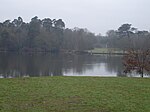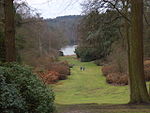Fort Belvedere, Surrey
1750 establishments in EnglandBuildings and structures in Windsor Great ParkCountry houses in SurreyCrown EstateEdward VIII ... and 8 more
Gothic Revival architecture in SurreyGrade II* listed buildings in SurreyGrade II* listed housesGrade I listed parks and gardens in SurreyHouses completed in 1755Houses completed in 1828Jeffry Wyatville buildingsRoyal residences in England

Fort Belvedere (originally Shrubs Hill Tower) is a Grade II* listed country house on Shrubs Hill in Windsor Great Park, in Surrey, England. The fort was predominantly constructed by Jeffry Wyatville in a Gothic Revival style in the 1820s. The fort was occupied by numerous members of the British royal family and associated personages from 1750 to 1976. From 1929 Fort Belvedere was the home of Edward, Prince of Wales, who greatly renovated the house and grounds, and it was the site of his abdication as King Edward VIII in 1936. The property remains part of the Crown Estate, is home to private tenants and is not open to the public.
Excerpt from the Wikipedia article Fort Belvedere, Surrey (License: CC BY-SA 3.0, Authors, Images).Fort Belvedere, Surrey
London Road,
Geographical coordinates (GPS) Address External links Nearby Places Show on map
Geographical coordinates (GPS)
| Latitude | Longitude |
|---|---|
| N 51.404433333333 ° | E -0.61245555555556 ° |
Address
Fort Belvedere
London Road
SL5 7SB
England, United Kingdom
Open on Google Maps





